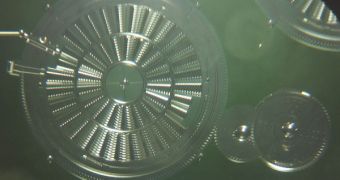The American Chemical Society (ACS) has announced the creation of microscopic robotic devices that act like small hands inside a host organism. They are capable of lifting small pieces of metal, or other objects, and transporting them where they are most needed. In addition to this remarkable feature, the devices themselves are not powered by batteries via wiring, like their predecessors were. Their actions are triggered by chemical signals, which opens the way for them to be created at an even smaller scale. The need for wiring and intricate operation systems is thus eliminated, and the machines can navigate sinuous places inside living bodies, without causing damage.
According to the announcement, the micro grippers, shaped like hands, are capable of operating entirely without electricity, and only use the chemical actuation properties that their biological counterparts in the human body, for example, do. The micro machines are built on a very small scale, and each of them measures only 0.03 inches (0.76 millimeters) when they are opened. The basic construction principle is very similar to that of the human hand, as the robots feature a gold-coated nickel “palm,” complete with 6 metallic fingers, which can be closed at the command of a specific chemical activator. All actions that the machines perform are ordered via specifically-designed chemicals, which ensure that there are no confusions in the process, and that the robot doesn't grip instead of releasing, or vice-versa. The researchers, led by David Gracias from Maryland, say that lab experiments have showed that their invention has a large array of application in the manufacturing industry, where pick-and-place abilities are paramount. In the trials, the group made the gripper take small pipes and glass beads, and transport them to a designated location, by using a magnet to attract the robotic gripper itself. The success of this technology depends entirely on how much progress the team will make from prototypes to working models. Undoubtedly, the research is due to draw a lot of attention from companies dealing with microscopic parts that need carefully-designed assembly tools in their facilities.
Researchers have developed the gadgets for many applications
hot right now

 14 DAY TRIAL //
14 DAY TRIAL //